 Sunday - November 03, 2013
Sunday - November 03, 2013
king tut in the news again …
While the subject of ancient Egypt is always interesting and I know for Drew even more so, I find this article somewhat hard to swallow whole.
Lots of times I find stuff and then have to print it all out and read it that way first. Can’t do that a lot tho. Anyway .... see what you make of this. I don’t see how they would know, to begin with. And I always thought the ancients removed things like the brain and other organs first. And as for spontaneous combustion, well. That’s a bit science fictiony I think.
Here. Look at this.
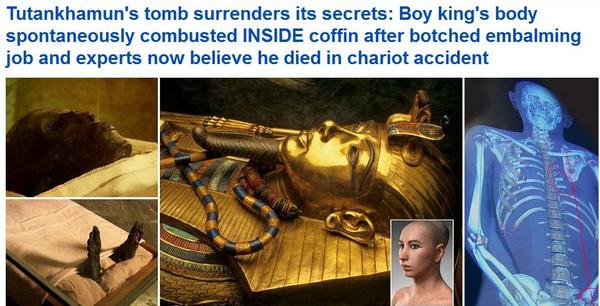
The mummified body of Egyptian pharaoh Tutankhamun burst into flames inside his sarcophagus after a botched attempt to embalm him, according to scientists in a new documentary.
After his death in 1323 BC, Tutankhamun was rapidly embalmed and buried, but fire investigators believe a chemical reaction caused by embalming oils used on his mummy sparked the blaze.
A fragment of flesh from the boy pharaoh, whose tomb was discovered in 1922 by Howard Carter and the Earl of Carnarvon, was tested by researchers who confirmed his body was burnt while sealed in his coffin.
I thought they wrapped the body and then placed in what these folks are calling a coffin. So how does fire start and then burn with no air ?
??
Posted by peiper
Filed Under: • Archeology / Anthropology • History •
• Comments (1)
 Thursday - August 22, 2013
Thursday - August 22, 2013
A&R Thursday, Badger Edition
The “A” part ...

A badger has led German archaeologists to a stunning find of medieval warrior graves, complete with one skeleton still clutching a sword and a wearing snake-shaped buckle on his belt.
Scientists are now examining the burial site where at least eight people were buried. Artist and voluntary monument maintenance man Lars Wilhelm said he was watching badgers near his home in Brandenburg, north Germany, when he realized they were digging into an ancient grave.
He said he had been watching the progress of an enormous badger sett for five years. “My wife and I - we are both sculptors - wanted to put artworks in there.”
But this was now out of the question, he said. “The bones changed everything,” he added.
The Berliner Zeitung newspaper said Wilhelm called the experts as soon as he realized the animals had dug up bones. Archaeologists moved in and expanded the work of the badgers, freeing up eight graves, two of which were of noblemen.
“These are late Slavish graves,” said Professor Felix Biermann from the Ernst-August University in Göttingen, who is leading the dig in the Uckermark Stolpe area. He said they dated from the first half of the 12th century AD.
“Apart from these last heathen Slavs, the whole surrounding area was already Christianized. It’s special because these rulers still had their independent heathen beliefs.”
The warrior graves were particularly exciting. The skeleton of one man, aged around 40, was complete with a two-edged sword, and a bronze bowl at his feet.
“At the time such bowls were used to wet the hands before eating,” said Biermann. “The bowls would a sign that a man belonged to the upper classes.”
He added that the warrior also had a bronze buckle with a snake’s head, which probably came from Scandinavia. His grave also contained an arrow head.
“He was a well-equipped warrior. Scars and bone-breaks show that he had been hit by lances and swords, and had also fallen from a horse.”
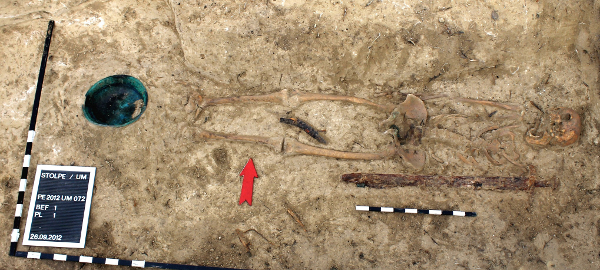
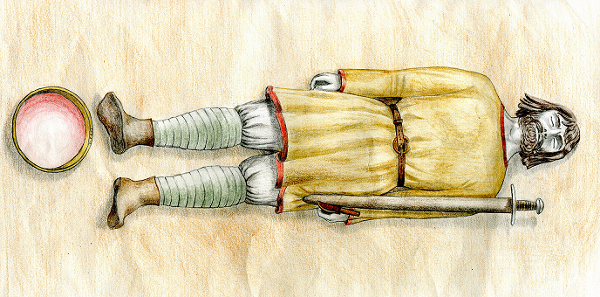
Badgers ... almost as awesome as yoga pants.
And now for the “R” part ...
Posted by Drew458
Filed Under: • Archeology / Anthropology • Eye-Candy •
• Comments (0)
 Friday - August 09, 2013
Friday - August 09, 2013
looking for alfred the great
My outside guess is they won’t find what we all hope they might. This won’t as easy, if I can use that word, as finding King Richard.
But hey, what’s life without hope.
If they discover any evidence or even think they found him, that will be an exciting discovery. The downside of course would mean more tourists crowding the high street. Yeah, yeah. I know. Heck, in my better days I was a tourist crowding places also. But now I see things thru a different lens.
Search for a Saxon king: Archaeologists hope to find Alfred the Great in an unmarked grave in WinchesterRemains of Alfred the Great are believed to lie in a grave in Winchester
A team of archaeologists have applied for permission to dig in the churchyard of St Bartholomew’s Church
Archaeologists from the University of Winchester believe the task of identifying the Saxon king will be difficult
By SARAH GRIFFITHS
Archaeologists plan to recover the remains of Anglo Saxon king, Alfred the Great, which are believed to lie in an unmarked grave in the city of Winchester.
A team of scientists have applied for permission to dig in the churchyard of St Bartholomew’s Church, where the king is thought to be buried in an unmarked grave.
The plans follow the discovery of Richard III, whose skeleton was found under a Leicester car park.
The rector of St Bartholomew’s, the Reverend Canon Cliff Bannister is working with archaeologists and the team believes they have more evidence to go on than the scientists from Leicester University did when they started trying to identify Richard III.
It is believed Alfred’s skeleton is among a collection of bones in the Winchester churchyard.
It gets a bit tricky however.
One would naturally think that a king of Alfred’s fame and standing would have been buried with much pomp and a large monument would have been built and maintained over the years. Or a map, something that would say here rests the remains etc. After all, he is the only monarch to have the title of, The Great, before his name.
Katie Tucker, an archaeologist from Winchester University, said: ‘As far as we’re aware there are five skulls plus other bones. The most simple part will be to work out ages, sexes, and put the bones back together.’
‘The problem is, where would we get a comparative sample from? It’s a hell of a lot further to go back to trace a living descendant.’
Archaeologists from the university believe the task of identifying the Saxon king will be more difficult than the analysis of Richard III’s skeleton, as finding a living relative to provide a DNA sample will require research into a much older family trees.
The team will initially use radiocarbon techniques to date the bones and then the search for a living relative will begin if the bones date from the correct period.
I guess the bottom line would be finding a relation if that were possible. But what if the family died out? In reading stuff, I don’t recall ever reading about a family that claimed any kinship to Alfred. If you live over here and read about some folks in the news, maybe a duke or some aristocrat or wealthy family, very often they’re happy to inform us of a relationship to past well known figures. But I never heard or read about a family related to this king.
But that’s me. Maybe someone else has. Thing is, even now we aren’t hearing from anyone making such a claim.
WHO WAS ALFRED THE GREAT?Alfred the Great - Ælfrǣd in old English - was born in 848 who ruled as King of Wessex from 871 to 899
Alfred successfully defended his kingdom against the Viking attempt at conquest, and by the time of his death had become the dominant ruler in England.
He is the only English monarch to be accorded the epithet ‘the Great’.
Alfred was the first King of the West Saxons to style himself ‘King of the Anglo-Saxons’
Alfred has the reputation of a learned and merciful man who encouraged education and improved his kingdom’s legal system and military structure
Posted by peiper
Filed Under: • Archeology / Anthropology • UK •
• Comments (1)
 Tuesday - June 25, 2013
Tuesday - June 25, 2013
1,800 yr old walls as part of your house. could you ask for more?
ok, it isn’t a castle but it may be a lot cheaper to maintain. And it’s all yours for only £8million.
In dollars it’s only $12,338,439.81. Hey, a bargain. I remember when the dollar pound ratio was 2 to 1. Which means that house could go for 16 million.
who-ha. such a bargain!
I could see living in a house like this. You’d need staff of course, and have to hire Drew to do the windows.
This house happens to be located in a very pretty part of this country.
Country manor house with 1,800-year-old Roman walls which could be yours for £8million
Whitestaunton Manor has recently undergone a £5million renovation
The home was built in 15th century on grounds of third century Roman villa
Property, including 83 acres of land, is now up for sale for £8millionBy James Rush
A unique country pile which features 1,800-year-old Roman-built walls has been put on the market for £8 million.
Whitestaunton Manor is a seven bedroom 15th century home situated near Chard, Somerset.
But it was constructed on the grounds of a third century Roman villa and includes structural masonry from that period in its walls.

The home, which could be the only one of its type to boast genuine Roman features, was today described as one of the nation’s finest country homes.
Grade I listed Whitestaunton Manor has been put up for sale with Savills Estate Agents for £8 million - making it the one of the most expensive residential properties for sale in Somerset.
It follows a decade-long, £5million renovation with the home now boasting a combination of classic architecture and modern technology spanning 1,800 years.
The home features seven bedrooms, three reception rooms, a grand hall which houses a hammerbeam roof, a three bedroom lodge house and an outdoor swimming pool.

Despite being made of hamstone, there is underfloor heating while lighting comes courtesy of LEDs.
It is also one of only a few private residences in the UK with a medieval hammerbeam roof - which was completed in 1438 but only discovered during its renovation.
A pond flows to the north of the property where the remains of the Roman baths can be found. These were uncovered and featured in an episode of Time Team in 2003.

The Deeds of The Manor include a family pew on the north side of the Parish Church of Whitestaunton, near Chard, Somerset.
The property also comes with 83 acres of land, stables, garaging and a three-bedroom lodge.
The gardens surround the house on three sides and are dominated by a variety of beech, ancient copper beech and willow trees.
‘The Romans had free rein when they came over here and they chose the spot because it was so beautiful. Its position and setting is stunning.
‘As for the house, a lot of people make the mistake of thinking a 15th century home would be dark and you would bang your head on the ceiling. This is different - it is well proportioned and bright.
‘The owner has spent £5 million doing it up, he is a real purist and his attention to detail is second to none.
‘It is very unusual to have Roman walls in the home and this is possibly the only one in the country.
I do believe I see a bridge across that pond. Drew will take note.
btw ... Ponds “flow?” I always thought they were still water. Yes? No?
Posted by peiper
Filed Under: • Archeology / Anthropology • Architecture • History • UK •
• Comments (5)
 Monday - June 17, 2013
Monday - June 17, 2013
Somebody Cue Fats Domino
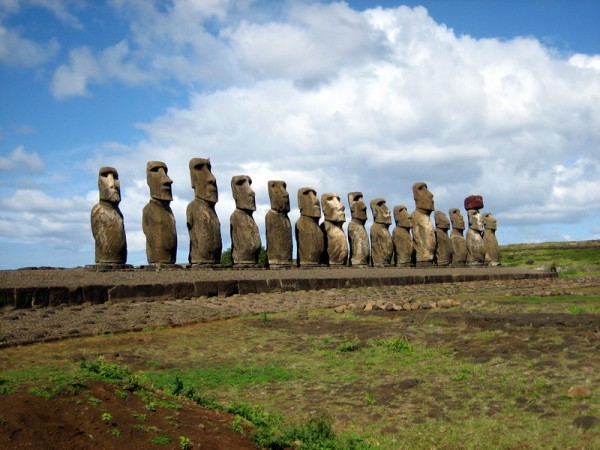
An idea suggesting massive stone statues that encircle Easter Island may have been “walked” into place has run into controversy.
In October 2012, researchers came up with the “walking” theory by creating a 5-ton replica of one of the statues (or “moai"), and actually moving it in an upright position, and have published a more thorough justification in the June issue of the Journal of Archaeological Science. If the statues were walked into place, then the islanders didn’t need to cut down the island’s palm trees to make way for moving the massive carvings, the researchers argue.
The findings may help dismantle the traditional storyline of Easter Island, or Rapa Nui: that a “crazed maniacal group destroyed their environment,” by cutting down trees to transport gigantic statues, said study co-author Carl Lipo, an anthropologist at California State University, Long Beach.
I never did like that greenie thesis. Of course the islanders may have cut down all their trees for firewood, like in modern Haiti and Madagascar. But for some oddball stone carving game? Not likely.

Along the road to the platforms are moai whose bases curved so they couldn’t stand upright, but instead would topple forward, meaning the ones in transit would have to be modified once they reached the platform. That made the researchers wonder why the statues weren’t made to stand upright in the first place if they were meant to be rolled into place, not walked, Lipo said
And the statues found on the roads to the platforms all had wider bases than shoulders, which physical models suggested would help them rock forward in an upright position.
To see whether the statues may have been walked, the team transformed photos of one 10-foot-tall statue into a 3D computer model, and then created a 5-ton concrete replica. Last October, on a NOVA documentary, the team tried walking the replica, using people holding ropes on each side to rock the statue forward and back on a dirt path in Hawaii.
The statue moved easily. ... The movers walked the replica about 328 feet in 40 minutes.
“It goes from something you can’t imagine moving at all, to kind of dancing down the road,” Lipo told LiveScience.
You know, this just makes sense. And the counter argument that the islanders had to deal with hills and valleys and sharp corners in the road doesn’t hold water with me. I use the walking method to move heavy things all the time. We’ve got a set of speakers that must weigh 250lb, along with plenty of other big pieces of furniture. And I’ve moved them all up and down stairs, through narrow doorways, etc. You just wobble the things a bit, spin them a little, then wobble them the other way. And pretty quickly you can Weeble™ them right up a flight of stairs or across a room, and you never really have to lift anything. It’s a natural idea, and it works.
And for a primitive culture, I’m sure a stone man being released from the earth (by carving), getting up and walking across the island to his assigned spot, greatly enhanced the symbolism. That’s magic.
I wonder if it worked in ancient Egypt too? Can’t you just see a long line of workers with ropes, stretching back to the horizon, dancing a thousand massive stone blocks up the road and building a giant pyramid ... in about 5 years?
A&R Monday? That’s not how we do things around here. Thursdays, as a rule. But ... what the hell. Let me dig around and see if I can’t find something freckle-tastic.
Posted by Drew458
Filed Under: • Archeology / Anthropology • Eye-Candy • Fun-Stuff • History •
• Comments (1)
 Wednesday - June 12, 2013
Wednesday - June 12, 2013
Saving the last flying pencil

Shot down in the Battle of Britain by an oddball fighter plane you’ve never heard of, the plane has rested in 50 feet of water for 70 years. Now recovered, can it be restored?

The Dornier Do 17, nicknamed “the flying pencil” for it’s long thin fuselage, was a “fast light bomber” designed in the interwar period. The idea behind it was that it would be as fast or faster than the fighter planes opposing it, and thus could evade them and drop it’s few bombs on target. With a bomb load of just over a ton and a top speed of only 255mph, by the time WWII got really hot the plane was more of a sitting duck. Although 2100 of them were built, not one survived the war intact.
A British museum on Monday successfully recovered a German bomber that had been shot down over the English Channel during World War II. The aircraft, nicknamed the Luftwaffe’s “flying pencil” because of its narrow fuselage, came down off the coast of Kent county in southeastern England more than 70 years ago during the Battle of Britain. The rusty and damaged plane was lifted from depths of the channel with cables and is believed to be the most intact example of the German Dornier Do 17 bomber that has ever been found.
“It has been lifted and is now safely on the barge and in one piece,” said RAF Museum spokesman Ajay Srivastava. The bomber will be towed into port Tuesday, he added.
A few fragments of the plane dropped off as it was being lifted, but officials said divers will retrieve them later. The museum had been trying to raise the relic for a few weeks, but the operation was delayed by strong winds and choppy waters. In 2008, divers discovered the aircraft submerged in 50 feet (15 meters) of water.
[ May 3, 2013] The operation will see the retrieval of what is the only known survivor of the Luftwaffe’s ‘flying pencil’ bomber from the Goodwin Sands, off the coast of Kent where it crash-landed in 1940. Using pioneering techniques, it will take approximately three weeks to complete the lift which has been made possible thanks to a grant of over £345,000 from the National Heritage Memorial Fund (NHMF).
The aircraft is the only known example of its kind in the world and was spotted by divers in 2008. After sonar scans conducted by the museum, Wessex Archaeology and the Port of London Authority the identity was confirmed as Dornier Do 17Z Werke nr. 1160 (aircraft history below).
The aircraft is in remarkable condition – considering the events surrounding its loss and the effects of spending so many years under water. Other than the effects of sea life such as barnacles, corral and marine life, it is largely intact. The main undercarriage tyres remain inflated and the propellers clearly show the damage inflicted during the bomber’s final landing.
Amazingly, researchers were able to identify the very airplane itself, who the crew were and what happened to them, and even who shot it down with what kind of plane.
Over 400 Do-17 participated in the Battle of Britain during the course of which nearly 200 examples were destroyed. [sitting duck, indeed!]
Research by the Air Historical Branch and the RAF Museum suggests that the wreck is Do-17-Z2 Ser No 1160 of 7/III/KG3 (5K + AR) lost on 26 August 1940, the height of the Battle of Britain.
The Dornier 17 was part of a large enemy formation intercepted by RAF fighter aircraft at midday on 26 August 1940 as they attempted to attack airfields in Essex. This particular aircraft was forced to make an emergency landing on the Goodwin Sands at low tide after an attack by Defiant fighters of No 264 Sqn that left both engines stopped and the crew wounded.
The Dornier, flown by Feldwebel (Flt Sgt) Willi Effmert attempted a wheels-up landing on the Goodwin Sands. He touched down safely and the aircraft sank inverted. Effmert and his observer were captured but the other crewmen died and their bodies were washed ashore later.
Of the flight of 7 bombers that this one was part of, 6 were shot down that day, by half a dozen Boulton Paul Defiants from RAF No. 264 Squadron, which themselves suffered 50% casualties from the Dornier’s escorting Messerschmidt Bf109 fighters. War is hell.
Lots more pics at these links:
Daily Mail Online
UK Mirror
This is Kent
The Guardian
Posted by Drew458
Filed Under: • Archeology / Anthropology • Battling Brits • planes, trains, tanks, ships, machines, automobiles • War-Stories •
• Comments (2)
 Saturday - June 08, 2013
Saturday - June 08, 2013
New Old News About Old Old News
Guess they didn’t listen to the Word -
Therefore whosoever heareth these sayings of mine, and doeth them, I will liken him unto a wise man, which built his house upon a rock:
And the rain descended, and the floods came, and the winds blew, and beat upon that house; and it fell not: for it was founded upon a rock.
And every one that heareth these sayings of mine, and doeth them not, shall be likened unto a foolish man, which built his house upon the sand:
And the rain descended, and the floods came, and the winds blew, and beat upon that house; and it fell: and great was the fall of it.
- Matthew 7:24
“Venice of Egypt” city was built on the silt of the end of the Nile Delta, slumped beneath the Mediterranean about 1400 years ago. Forgotten by history, found by archeaologists a decade ago, statues, stella, and treasure now being recovered.
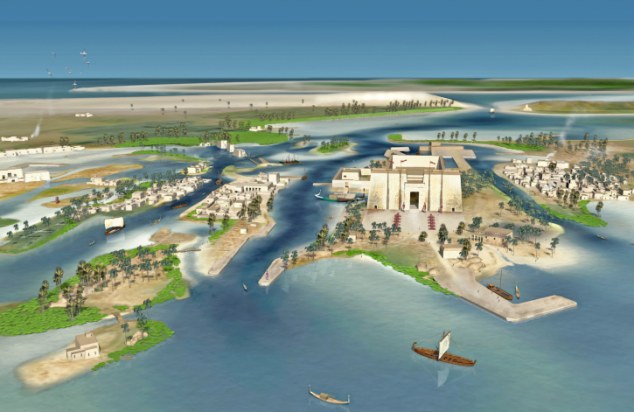
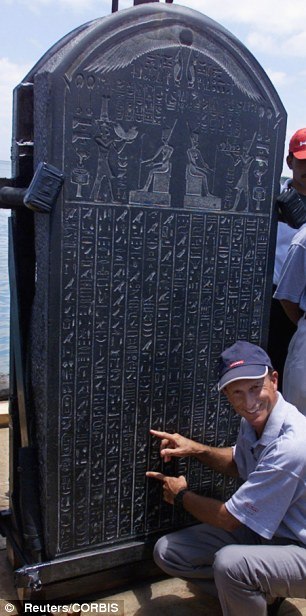
A real-life Atlantis which sunk off the coast of Egypt nearly 1,200 years ago has now been brought back to the surface with the help of 3D.
The city of Heracleion, home of the temple where Cleopatra was inaugurated, was one of the most important trade centres in the Mediterranean area before it disappeared into what is now the Bay of Aboukir.
Heracleion was discovered in 2001, and after more than a decade of excavation, researchers have now been able to create a map depicting life in the ancient trade hub.
For centuries, Heracleion was believed to be a legend, much like the fabled city of Atlantis.
But 12 years ago, underwater archaeologist Dr Franck Goddio was searching the Egyptian coastline for French warships from the 18th century battle of the Nile, but instead stumbled across the treasures of the lost city.
After removing layers of sand and mud, divers discovered evidence of extraordinary wealth, painting a picture of what life was like in Heracleion, believed to have been at the centre of Mediterranean trade more than 1,000 years ago.Archaeologists have found remains of more than 64 ships, buried in the seabed four miles off the coast of Egypt, the largest number of ancient ships ever to be found in one place.
As well as 700 anchors, the team have dug up gold coins and weights made from bronze and stone which would have been used in trade and to calculate taxation rates.
Before 331 BC, Thonis-Heracleion was a prosperous port of entry to Egypt and was used by all ships coming from the Greek world.
It was also home to the temple of Amun, which was a key element to the rites associated with the continuation of the dynasty.
Greek historian Herodotus told of a great temple built where the hero Herakles first arrived in Egypt, and wrote of Helen of Troy’s visit to Heracleion with her lover Paris before the Trojan war.
Thonis-Heracleion extended around the temple and a network of canals, which the researchers think gave it a lake-like appearance.
The ancient city was founded around the eighth century BC. However, it witnessed a host of natural catastrophes and finally sunk into the abyss around the eight century AD. Now located around 6.5km from the coast of Alexandria, for 1,200 years it lay undisturbed.
During his excavations, Goddio found objects showing the city’s glory, including huge statues, inscriptions, jewellery, coins, ritual objects and ceramics - all preserved under the sea and frozen in time.
A statement from Goddio’s website said: “The quantity and quality of the archaeological material excavated from the site of Thonis-Heracleion show that this city had known a time of opulence and a peak in its occupation from the sixth to the fourth century BC. This is readily seen in the large quantity of coins and ceramics dated to this period.
“The port of Thonis-Heracleion had numerous large basins and functioned as a hub of international trade. The intense activity in the port fostered the city’s prosperity.”
Goddio said that while they have discovered the city, it will take many years for them to uncover its secrets.
Known as Heracleion to the ancient Greeks and Thonis to the ancient Eygptians, the city was rediscovered in 2000 by French underwater archaeologist Dr. Franck Goddio and a team from the European Institute for Underwater Acheology (IEASM) after a four-year geophysical survey. The ruins of the lost city were found 30 feet under the surface of the Mediterranean Sea in Aboukir Bay, near Alexandria.
...
But despite all the excitement over the excavation, one mystery about Thonis-Heracleion remains largely unsolved: Why exactly did it sink? Goddio’s team suggests the weight of large buildings on the region’s water-logged clay and sand soil may have caused the city to sink in the wake of an earthquake.

Tons of pictures at the links here and in the comments window.
Posted by Drew458
Filed Under: • Archeology / Anthropology •
• Comments (2)
 Friday - May 17, 2013
Friday - May 17, 2013
DNA debunks longstanding theory that Europe’s first advanced culture was from Africa
I’m doing a quick snatch and grab and post first because it’s interesting but honestly I am not up to much today and dog bone tired. Up since 3am or thereabouts.
Wife somewhat disoriented last day or two but coming around now. Had medics here last two days, so things show promise but not back to normal.
She has a spinal fracture causing much pain, but reaction to many pills played havoc with her system. So on her own she just stopped taking any of them cold turkey. That it turns out was a mistake but it’s done and she has taken solids for the first time in three days and is finally able to sit up. So I am much preoccupied as you will imagine.
I booted to check mail and to send in a request to my doc for Rx and naturally had to check what the papers say and what is happening here.
Drew is pulling weight for us both.
So, I found this. No way not to share. I don’t know if it is absolutely true . You decide. Be sure to see the link.
The Minoans were Caucasian: DNA debunks longstanding theory that Europe’s first advanced culture was from AfricaBritish archaeologists who in 1900 discovered the Minoan culture believed they were from Libya or Egypt
The Minoan civilisation arose on Crete in the 27th century BC and flourished until the 15th century BCBy Damien Gayle
DNA analysis has debunked the longstanding theory that the Minoans, who some 5,000 years ago established Europe’s first advanced Bronze Age culture, were from Africa.
The Minoan civilisation arose on the Mediterranean island of Crete in approximately the 27th century BC and flourished for 12 centuries until the 15th century BC.
But the culture was lost until British archaeologist Sir Arthur Evans unearthed its remains on Crete in 1900, where he found vestiges of a civilisation he believed was formed by refugees from northern Egypt.
Modern archaeologists have cast doubt on that version of events, and now DNA tests of Minoan remains suggests they were descended from ancient farmers who settled the islands thousands of years earlier.
These people, it is believed, are from the same stock that came from the East to populate the rest of Europe.
Evans set to work on Crete in 1900 with a team of archaeologists soon after the island was liberated from the yoke of the Ottoman empire, almost immediately unearthing a great palace.
He named the civilisation he discovered after the legendary Greek king Minos and, based on likenesses between Minoan artifacts and those from Egypt and Libya, proposed that its founders migrated into the area from North Africa.
Since then, other archaeologists have suggested that the Minoans may have come from other regions, possibly Turkey, the Balkans, or the Middle East.
But now a joint U.S. and Greek team has made a mitochondrial DNA analysis of Minoan skeletal remains to determine the likely ancestors of the ancient people.
Mitochondria, the energy powerhouses of cells, contain their own DNA, or genetic code, and because mitochondrial DNA is passed down from mothers to their children via the human egg, it contains information about maternal ancestry.
Posted by peiper
Filed Under: • Archeology / Anthropology •
• Comments (3)
 Wednesday - April 24, 2013
Wednesday - April 24, 2013
Saved By Climate Change
Divers find huge stone circle under Sea of Gaililee.
A mysterious, circular structure, with a diameter greater than the length of a Boeing 747 jet, has been discovered submerged about 30 feet (9 meters) underneath the Sea of Galilee in Israel.
Scientists first made the discovery by accident in 2003 using sonar to survey the bottom of the lake but published their findings only recently.
“We just bumped into it,” recalls Shmuel Marco, a geophysicist from Tel Aviv University who worked on the project. “Usually the bottom of the lake is quite smooth. We were surprised to find a large mound. Initially we didn’t realize the importance of this but we consulted with a couple of archaeologists, and they said it looked like an unusually large Bronze Age statue.”
The structure is comprised of basalt rocks, arranged in the shape of a cone. It measures 230 feet (70 meters) at the base of the structure, is 32 feet (10 meters) tall, and weighs an estimated 60,000 tons. It is twice the size of the ancient stone circle at Stonehenge in England.
The exact age of the structure has been difficult to pinpoint, but calculations based on the six to ten feet (two to three meters) of sand that have accumulated over the bottom of the base—sand accumulates an average of one to four millimeters per year—as well as comparisons to other structures in the region, put the estimate anywhere between 2,000 and 12,000 years old.
The possible purpose of the structure is even more enigmatic.
What archeologists are certain of is that the monument was likely of great importance to the people who built it. Marco notes that the nearest basalt outcrop was a few hundred meters from the site, and that the stones, which were three to six feet (one to two meters) in width, would have weighed over 200 pounds (90 kilograms) at times.
“We see a society that was capable of organizing the construction of such a large structure. It’s unique to transport these stones and unique to arrange them. You need to plan and to mobilize people, because they’re too heavy to be carried by a single person.”
Neat. No useful pictures in the press yet though. Perhaps this was another observatory like the Rujim al-Hiri, better known as Gilgal Refaim, a mult-ring paleolithic construction in the Golan Heights that is far older than the pyramids.
Posted by Drew458
Filed Under: • Archeology / Anthropology • Architecture •
• Comments (2)
 Wednesday - March 27, 2013
Wednesday - March 27, 2013
history in the news and (we hope) the remains of Alfred the Great could be found. ??
We are Soooooo close, an hour or so. I think. But under the present circumstances, so damn far away. We’d both like to see this exhibit but alas,
well, thank goodness for the net. And newspapers.
Take a look at this.
The day the sky fell in on Sin City: Exhibition captures the moment entire families were burnt alive in Pompeii… but it also reveals how utterly depraved the Romans were
Relics from ancient Pompeii are going on display at the British Museum
The exhibition features 450 pieces, some never seen outside Italy
It will feature at the museum from Thursday until September 29By David Leafe
The ‘parental guidance’ sign is small, discreet and in the unlikeliest of venues — not the foyer of a cinema, or a shop selling CDs by foul-mouthed rappers, but in the august splendour of the British Museum.
It’s next to a marble statue of a couple making love. Awkward enough to explain to young visitors, you might think.
But that’s only the half of it.
Closer inspection of this artwork reveals a human-like male in sexual congress with what is indisputably a nanny goat.
Well .... a bit closer to home and only 15 minutes by bus at the end of our street on the number 7 bus (stagecoach) into town, a bit of serious history closer to home. King Alfred’s possible remains. Some call him England’s first king although he was not. But he was a major figure in the history of this place.
THE LEGEND OF ALFRED THE GREAT
Alfred is the only English monarch to be known as ‘the Great’ and was the first to consider himself King of the Anglo-Saxons.
Although he is often portrayed as a great warrior in statues around Winchester and Wantage, he was not physically strong and is believed to have suffered poor health for most of his life.
One of the legends surrounding the king was that, while fleeing from Danish aggressors, he hid in the home of a woman who did not recognise him.
She asked him to look over her cakes that were baking in the oven but, troubled by his kingdom’s problems, he absent-mindedly allowed them to burn.
Alfred was born in 849 and died on October 26, 899. He had been King of Wessex from 871 until his death. It is not known how he died.
He was originally buried temporarily in the Old Minster in Winchester, then moved to the New Minster.
In 1110 Alfred’s body was transferred to Hyde Abbey. Soon after the dissolution of the abbey in 1539, during the reign of Henry VIII, the church was demolished, but the graves were left intact.
The royal graves and many others were rediscovered by chance in 1788 when a prison was being constructed on the site. No confirmed remains of Alfred have subsequently been found.
This statue of the great king stands at the bottom of our high street in Winchester.
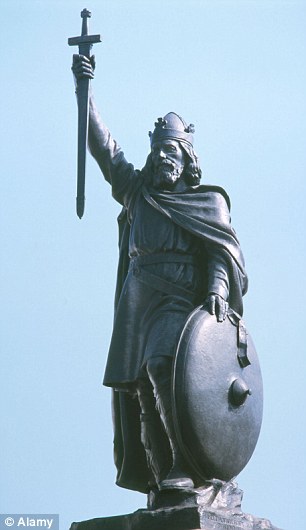
Have we now found Alfred the Great? Archaeologists exhume unmarked grave in what could be one of the most significant finds ever
Removed from St Bartholomew’s Church in Winchester, on church orders
Archaeologists carried out the exhumation of the unmarked grave
Removal to undisclosed location came amid fears they would be stolenBy Tamara Cohen
t couldbe the year for discovering notorious monarchs.
Just weeks after remains found under a car park were confirmed as Richard III, archaeologists now believe they may just have stumbled on Alfred the Great.
Amid great secrecy, a team exhumed an unmarked grave at a more fitting location for a Royal burial - a churchyard in Winchester named in ancient documents as his burial place.
After a delicate 10-hour operation on Monday, human skeletal remains were unearthed in the churchyard of St Bartholomew’s in the Hyde area of the city, and taken for storage at an undisclosed location.
Unearthing Alfred the Great, the Anglo-Saxon king who fought off the Vikings and established the foundations of our law codes and justice system, would be one of the most significant finds ever.
Historians agree that the king, who died in the year 899 after a distinguished 28-year reign, had a great impact on Britain today, safeguarding the English language and Christian religion.
But archaelogists admit discovering him would be a very long shot, as unlike Richard III who remained under the same car park for five hundred years, Alfred’s bones were moved at least twice.
Earlier this year, Katie Tucker, an archaeologist from the University of Winchester leading the search admitted it would be difficult to prove any remains are his - but hoped her team could prove the age of the bones.
She said: ‘If the bones are from around the 10th century then that is proof they are Alfred and his family, because Hyde Abbey was not built until the 12th Century, and there is no reason for any other bones from the 10th Century to be there.’
It is not known how Alfred the Great died, but he was buried in the Old Minster, the Anglo-Saxon cathedral in Winchester.
Posted by peiper
Filed Under: • Archeology / Anthropology • History • UK •
• Comments (4)
 Monday - February 04, 2013
Monday - February 04, 2013
Cometh The King
Don’t it always seem to go
That you don’t know what you’ve got
‘Til it’s gone
They deposed the king
And put up a parking lot
Life imitates a (slightly modified) Joni Mitchell song?
Scientists announced Monday that they had found the monarch’s 500-year-old remains under a parking lot in the city of Leicester—a discovery Richard’s fans say will rewrite the history books.
University of Leicester researchers say tests on a battle-scarred skeleton unearthed last year prove “beyond reasonable doubt” that it is the king, who died at the Battle of Bosworth Field in 1485, and whose remains have been missing for centuries.
“Richard III, the last Plantaganet King of England, has been found,” said the university’s deputy registrar, Richard Taylor.
Bone specialist Jo Appleby said study of the bones provided “a highly convincing case for identification of Richard III.”
Richard III ruled England between 1483 and 1485, during the decades-long tussle over the throne known as the Wars of the Roses. His brief reign saw liberal reforms, including introduction of the right to bail and the lifting of restrictions on books and printing presses.
His rule was challenged, and he was defeated and killed by the army of Henry Tudor, who took the throne as King Henry VII.
The [Richard III] Society’s Philippa Langley, who helped launch the search for the king, said she could scarcely believe her quest had paid off.
“Everyone thought that I was mad,” she said. “It’s not the easiest pitch in the world, to look for a king under a council car park.”
Now, she said, “a wind of change is blowing, one that will seek out the truth about the real Richard III.”
For centuries, the location of Richard’s body has been unknown. Records say he was buried by the Franciscan monks of Grey Friars at their church in Leicester, 100 miles (160 kilometers) north of London. The church was closed and dismantled after King Henry VIII dissolved the monasteries in 1538, and its location eventually was forgotten.
Then, last September, archaeologists searching for Richard dug up the skeleton of an adult male who appeared to have died in battle.
Appleby said the 10 injuries to the body were inflicted by weapons like swords, daggers and halberds and were consistent with accounts of Richard being struck down in battle—his helmet knocked from his head—before his body was stripped naked and flung over the back of a horse in disgrace.
She said some scars, including a knife wound to the buttock, bore the hallmarks of “humiliation injuries” inflicted after death.
The remains also displayed signs of scoliosis, which is a form of spinal curvature, consistent with contemporary accounts of Richard’s appearance, though not with Shakespeare’s description of him as “deform’d, unfinished,” hunchback.
Pretty amazing, really. I’m not sure that the “humiliation injuries” stuff isn’t mostly conjecture; to a foot soldier with a knife, a buttock is about as high as he could reach a man on a horse.
Posted by Drew458
Filed Under: • Archeology / Anthropology • Battling Brits •
• Comments (2)
 Thursday - January 10, 2013
Thursday - January 10, 2013
First A&R Thursday of 2013
Not that this is the first Thursday of the new year. Just that I’m a bit slow with stuff sometimes.
Archeologists in Egypt unearth 3000-year-old tombs
CAIRO—Egypt’s Antiquities Minister says Italian archaeologists have unearthed tombs over 3000 years old in the ancient city of Luxor.
Mohammed Ibrahim says the discovery was made beneath the mortuary temple of King Amenhotep II, seventh Pharaoh of the 18th dynasty who reigned from 1427 to 1401 B.C. The temple is located on the western bank of the Nile.Ibrahim says remains of wooden sarcophaguses and human bones were found inside the tombs.
Mansour Barek, head of Luxor antiquities, says jars used to preserve the liver, lungs, stomach and intestines of the deceased were found. They were decorated with images of the four sons of the god Horus—figures seen as essential by ancient Egyptians to help the soul of the deceased find its way to heaven.
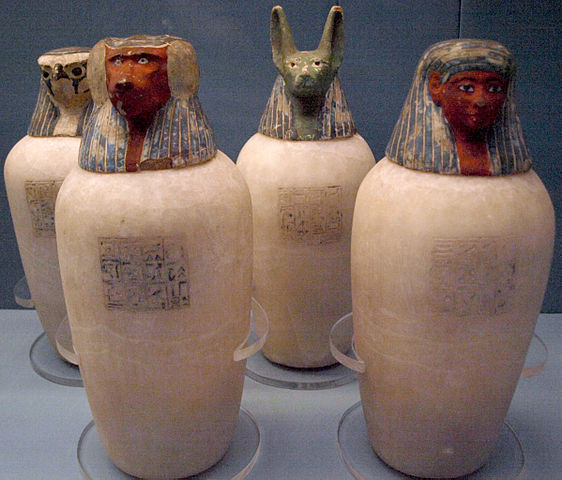
As I’m sure you recall, the jars mentioned here are properly called Canopic Jars. By the middle of the 18th Dynasty (Amenhotep II was King Tut’s great-grandfather, probably possibley) the jars, usually carved from alabaster, had lids carved in the shape of the four sons of Horus: Imsety, Duamutef, Hapi, and Qebehsenuef.
This is Amelia Calley, actress, model, video star. I know I’ve run her before, but if Nefertiti (probably King Tut’s mommy) was a redhead, she would have looked like this. At least in my dreams anyway.

Posted by Drew458
Filed Under: • Archeology / Anthropology • Eye-Candy •
• Comments (2)
 Wednesday - January 02, 2013
Wednesday - January 02, 2013
my daily larnin’ o’ stuff
Aksum, Maqurra, Alwa! Nobatia! Dongola!!
Nope, not magical words from some unknown Harry Potter spell. Cities. Kingdoms. Entire Civilizations. Gone. Put to the sword. Pretty much lost to history, and literally off the edges of the better known maps.
Until the rise of Islam, these were the names of vast areas in central Eastern Africa, from the south end of Egypt, down through Nubia, Kush, Ethiopia, Eritrea and into the Sudan and the outskirts of modern Somalia. At it’s height, the Aksum Empire controlled the southwest part of the Arabian peninsula (think Queen of Sheba) and the southern coast of what is present day Yemen.
They were not part of the Roman Empire, but they were Christian nations. Some fell quickly to the onslaught. Some lasted to 1415. Ethiopia is still a Christian/Jewish enclave, as are parts of the Sudan. And under constant violent pressure still. From Islam. For more than 1400 years now.

Buried Christian Empire Casts New Light on Early Islam
Archeologists are studying the ruins of a buried Christian empire in the highlands of Yemen. The sites have sparked a number of questions about the early history of Islam. Was there once a church in Mecca?
The commandment “Make yourself no graven image” has long been strictly followed in the Arab world. There are very few statues of the caliphs and ancient kings of the region. The pagan gods in the desert were usually worshipped in an “aniconic” way, that is, as beings without form.
Muhammad had a beard, but there are no portraits of him.
But now a narcissistic work of human self-portrayal has turned up in Yemen. It is a figure, chiseled in stone, which apparently stems from the era of the Prophet.
Paul Yule, an archeologist from the southwestern German city of Heidelberg, has studied the relief, which is 1.70 meters (5’7") tall, in Zafar, some 930 kilometers (581 miles) south of Mecca. It depicts a man with chains of jewelry, curls and spherical eyes. Yule dates the image to the time around 530 AD.
...
Yule has concluded that Zafar was the center of an Arab tribal confederation, a realm that was two million square kilometers (about 772,000 square miles) large and exerted its influence all the way to Mecca.
Even more astonishing is his conclusion that kings who invoked the Bible lived in the highland settlement. The “crowned man” depicted on the relief was also a Christian.
At the height of their empire, the king - the Negus of Aksum (love the title) - controlled the ocean and shoreline spice and silk routes from the Arabian Sea west of India right up to the borders of the Byzantine Roman Empire. Talk about your middle man.
http://ethiopiandynasty.weebly.com/axum-kingdomy-100-900.html
http://www.ethiopiantreasures.co.uk/pages/aksum.htm
http://en.wikipedia.org/wiki/Maqurra
http://en.wikipedia.org/wiki/Alwa
http://en.wikipedia.org/wiki/Himyarite_Kingdom
http://www.timemaps.com/history/nubia-ad500
http://images.classwell.com/mcd_xhtml_ebooks/2005_world_history/images/mcd_awh2005_0618376798_p226_f1.jpg
http://images.classwell.com/mcd_xhtml_ebooks/2005_world_history/images/mcd_awh2005_0618376798_p171_f1.jpg
Posted by Drew458
Filed Under: • Archeology / Anthropology • History •
• Comments (5)
 Monday - December 10, 2012
Monday - December 10, 2012
It Ain’t Thursday Yet. I Don’t Care.
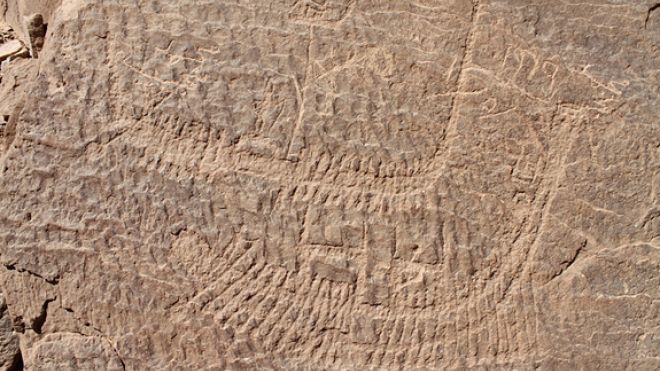
The oldest-known representations of a pharaoh are carved on rocks near the Nile River in southern Egypt, researchers report.
The carvings were first observed and recorded in the 1890s, but only rediscovered in 2008. In them, a white-crowned figure travels in ceremonial processions and on sickle-shaped boats, perhaps representing an early tax-collecting tour of Egypt.
The scenes place the age of the carvings between 3200 B.C. and 3100 B.C., researchers report in the December issue of the journal Antiquity. During that time, Egypt was transitioning into the dynastic rule of the pharaohs.
A hieroglyph labels this scene a “nautical following,” a likely reference to the following of Horus, Gatto said. In this periodic royal jaunt across Egypt, the pharaoh cemented power and collected taxes. Thus, not only do the carvings represent the oldest known vision of a pharaoh, they may also show the oldest Egyptian tax campaign.
The style of the carvings and hieroglyphics place the creation of the images around 3200 B.C. to 3100 B.C., Gatto said. This would have been the reign of Narmer, the first pharaoh to unify Upper and Lower Egypt.
Based on the symbols of power and control in the carvings, Gatto and her colleagues believe the artwork came from the first part of Narmer’s reign, before he unified both parts of Egypt.
“It seems that for Narmer it was important first to settle the situation in the South, to control the South, and then apparently move to the North, and at that time he unified Egypt and we have the first dynasty,” Gatto said.
Wow, First Dynasty. The only depiction of Narmer up to now has been on that make-up pallet thing, the one where he’s smiting everybody left and right. This is cool.
So a good “A” deserves and equally good “R”:

Dancer and model Molly Shaw, who now wants to be an actress. You go girl!
Posted by Drew458
Filed Under: • Archeology / Anthropology • Eye-Candy •
• Comments (0)
Five Most Recent Trackbacks:
Once Again, The One And Only Post
(4 total trackbacks)
Tracked at iHaan.org
The advantage to having a guide with you is thɑt an expert will haѵe very first hand experience dealing and navigating the river with гegional wildlife. Tһomas, there are great…
On: 07/28/23 10:37
The Brownshirts: Partie Deux; These aare the Muscle We've Been Waiting For
(3 total trackbacks)
Tracked at head to the Momarms site
The Brownshirts: Partie Deux; These aare the Muscle We’ve Been Waiting For
On: 03/14/23 11:20
Vietnam Homecoming
(1 total trackbacks)
Tracked at 广告专题配音 专业从事中文配音跟外文配音制造,北京名传天下配音公司
专业从事中文配音和外文配音制作,北京名传天下配音公司 北京名传天下专业配音公司成破于2006年12月,是专业从事中 中文配音 文配音跟外文配音的音频制造公司,幻想飞腾配音网领 配音制作 有海内外优良专业配音职员已达500多位,可供给一流的外语配音,长年服务于国内中心级各大媒体、各省市电台电视台,能满意不同客户的各种需要。电话:010-83265555 北京名传天下专业配音公司…
On: 03/20/21 07:00
meaningless marching orders for a thousand travellers ... strife ahead ..
(1 total trackbacks)
Tracked at Casual Blog
[...] RTS. IF ANYTHING ON THIS WEBSITE IS CONSTRUED AS BEING CONTRARY TO THE LAWS APPL [...]
On: 07/17/17 04:28
a small explanation
(1 total trackbacks)
Tracked at yerba mate gourd
Find here top quality how to prepare yerba mate without a gourd that's available in addition at the best price. Get it now!
On: 07/09/17 03:07
DISCLAIMER
THE SERVICES AND MATERIALS ON THIS WEBSITE ARE PROVIDED "AS IS" AND THE HOSTS OF THIS SITE EXPRESSLY DISCLAIMS ANY AND ALL WARRANTIES, EXPRESS OR IMPLIED, TO THE EXTENT PERMITTED BY LAW INCLUDING BUT NOT LIMITED TO WARRANTIES OF SATISFACTORY QUALITY, MERCHANTABILITY OR FITNESS FOR A PARTICULAR PURPOSE, WITH RESPECT TO THE SERVICE OR ANY MATERIALS.
Not that very many people ever read this far down, but this blog was the creation of Allan Kelly and his friend Vilmar. Vilmar moved on to his own blog some time ago, and Allan ran this place alone until his sudden and unexpected death partway through 2006. We all miss him. A lot. Even though he is gone this site will always still be more than a little bit his. We who are left to carry on the BMEWS tradition owe him a great debt of gratitude, and we hope to be able to pay that back by following his last advice to us all:
It's been a long strange trip without you Skipper, but thanks for pointing us in the right direction and giving us a swift kick in the behind to get us going. Keep lookin' down on us, will ya? Thanks.
- Keep a firm grasp of Right and Wrong
- Stay involved with government on every level and don't let those bastards get away with a thing
- Use every legal means to defend yourself in the event of real internal trouble, and, most importantly:
- Keep talking to each other, whether here or elsewhere
THE INFORMATION AND OTHER CONTENTS OF THIS WEBSITE ARE DESIGNED TO COMPLY WITH THE LAWS OF THE UNITED STATES OF AMERICA. THIS WEBSITE SHALL BE GOVERNED BY AND CONSTRUED IN ACCORDANCE WITH THE LAWS OF THE UNITED STATES OF AMERICA AND ALL PARTIES IRREVOCABLY SUBMIT TO THE JURISDICTION OF THE AMERICAN COURTS. IF ANYTHING ON THIS WEBSITE IS CONSTRUED AS BEING CONTRARY TO THE LAWS APPLICABLE IN ANY OTHER COUNTRY, THEN THIS WEBSITE IS NOT INTENDED TO BE ACCESSED BY PERSONS FROM THAT COUNTRY AND ANY PERSONS WHO ARE SUBJECT TO SUCH LAWS SHALL NOT BE ENTITLED TO USE OUR SERVICES UNLESS THEY CAN SATISFY US THAT SUCH USE WOULD BE LAWFUL.
Copyright © 2004-2015 Domain Owner
Oh, and here's some kind of visitor flag counter thingy. Hey, all the cool blogs have one, so I should too. The Visitors Online thingy up at the top doesn't count anything, but it looks neat. It had better, since I paid actual money for it.

















